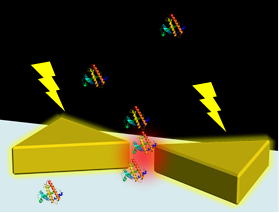1. Current Research and Principal Research Interests
<Plasmonic Optical tweezer>
Optical trapping techniques have been extensively investigated as
noninvasive and versatile manipulation tools. With a conventional
optical tweezer using a focused laser beam, micro-meter-sized
particles such as artificial beads and living cells can be stably
trapped and manipulated at a focal point.1, 2 However, the
techniques still have disadvantages for stable trapping of smaller
nanoparticles. Specifically, high laser intensity is needed to
overcome the Brownian motion of nanoparticles, and the diffraction
limit of incident light prevents the spatial resolution of the
trapping from being finer than several hundreds of nanometers. We
can potentially overcome these disadvantages by combining optical
trapping with metallic nanostructures to enhance the electromagnetic
field of the incident light with localized surface plasmons (LSPs).
A localized surface plasmon, a kind of polariton, is a cooperative
oscillation of free electrons in a metal. When plasmonic
nanostructures are irradiated with resonant light, the
electromagnetic field of the light is strongly localized in the
nanostructured area, whose size is much smaller than the light’s
diffraction limit.4 Consequently, plasmonic structures generate much
larger trapping forces using incident light of lower intensity than
that used in conventional optical tweezers.
Along with we report such LSP-based optical trapping of organic
nanoparticle systems, which formed interesting micropatterns. First,
we investigated LSP-based optical trapping of dye-doped polystyrene
nanospheres (500nm diameter) by means of fluorescence
microspectroscopy and microscopic realtime video observation. We saw
that the nanospheres were optically trapped to be closely packed on
the plasmonic substrate, and finally formed a 2D hexagonal
micro-assembly at the LSP excitation area (See Figure).

2. Selected Publications
(1) "Permanent Fixing or Reversible Trapping
and Release of DNA Micropatterns on a Gold Nanostructure Using
Continuous-Wave or Femtosecond-Pulsed Near-Infrared Laser Light"
Tatsuya
Shoji, Junki Saito, Noboru Kitamura, Fumika Nagasawa, Kei Murakoshi,
and Yasuyuki Tsuboi*, J. Am. Chem. Soc. Vol. 135,
No. 17 (2013) 135, pp. 6643-6648.
(2) "Resonant Excitation Effect on Optical Trapping of
Myoglobin: The Important Role of a Heme Cofactor"
Tatsuya
Shoji, Noboru Kitamura, and Yasuyuki Tsuboi*, J. Phys. Chem. C Vol.
117, No. 20 (2013), pp.
10691-10697.
(3) "Accelerating the Phase Separation in Aqueous
Poly(N-isopropylacrylamide) Solutions by Slight Modification of the
Polymer Stereoregularity: A Single Molecule Fluorescence Study"
Takanori
Tada, Yukikteru Katsumoto, KarelGoossens, Hiroshi Uji-I, Johan
Hofkens, Tatsuya Shoji, Noboru
Kitamura*, and
Yasuyuki Tsuboi*, J. Phys. Chem. C Vol. 117, No. 20 (2013), pp. 10818?10824.
(4)
"Temperature Near Gold Nanoparticles under Photoexcitation of
Surface Plasmon Band: Evaluation using a Fluorescence Correlation
Technique"
Hiroaki
Yamauchi,Syoji Ito, Ken-ichi Yoshida, Tamitake Itoh, Yasuyuki Tsuboi, Noboru
Kitamura and
Miyasaka, Hiroshi, J. Phys. Chem. C Vol. 117, No. 16 (2013) pp. 8388-8396.
(5) "Plasmon-Enhanced Photoluminescence and
Photocatalytic Activities of Visible-Light-Responsive ZnS-AgInS2
Solid Solution Nanoparticles"
Takuya Takahashi, Akihiko Kudo, Susumu Kuwabata, Akira
Ishikawa, Hajime Ishihara, Yasuyuki Tsuboi, and Tsukasa Torimoto, J. Phys. Chem. C, Vol. 117, No. 6 (2013) pp. 2511-2520.
(6) "Reversible Photoinduced-Formation and Manipulation
of a Two-dimensional Closely Packed Assembly of Polystyrene
Nanospheres on a Metallic Nanostructure"
Tatsuya
Shoji, Noboru Kitamura, Fumika Nagasawa, Kei Murakoshi, Hajime
Ishihara, and Yasuyuki Tsuboi*, J. Phys. Chem. C. Vol.
117, No. 6 (2013) pp.
2500-2506.
|